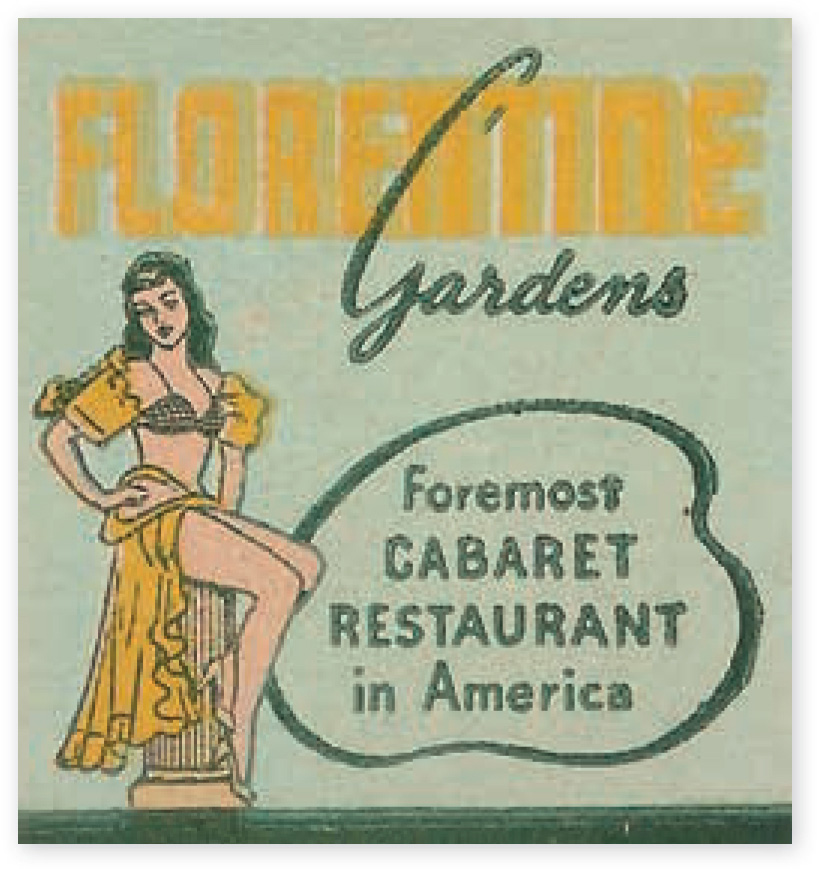OPEN: 1938–present
LOCATION: 5955 Hollywood Boulevard Los Angeles, CA 90028
ORIGINAL PHONE: HE-4801 and HO-6311
CURRENT PHONE: (323) 464-0706
CUISINE: Italian
DESIGN: Gordon Kaufmann (original design); Paul Revere Williams (1953 modifications)
BUILDING STYLE: Florentine

RADIO WAS BIG IN THE 1930S AND ’40S, WITH STATIONS LINING THE STREETS AROUND HOLLYWOOD AND VINE. They beckoned listeners, dancers, and entertainers to come to Hollywood, an invitation that brought large crowds from the suburbs on the weekends.
In the heyday of the Golden Age, ballrooms packed with big-band sounds filled the Hollywood scene. The opening of Florentine Gardens was not as big as the star-studded Palladium’s grand event two years earlier. Even so, when emcee Nils Thor Granlund opened the Gardens, it took off from its first day. Many who could not get into Earl Carroll’s nearby would settle for the Gardens, which was large enough to hold more than a thousand guests for dinner.
The nightclub’s acts ranged from scantily dressed or partly nude showgirls to the all-American Ozzie Nelson. Other performers included the Mills Brothers jazz group, acclaimed dancer Yvonne De Carlo, Tony Award-winning actress and dancer Gwen Verdon, burlesque dancer Sally Rand, and the comical and risqué Sophie Tucker Revue. Sometimes the acts featured entertainers hanging from the ceiling over the diners on swings.
True to its name, Florentine Gardens was decorated in ancient Florentine style, with faux-painted columns surrounding the largest spring dance floor on the West Coast at the time. The club served Italian fare, paired with salads and roasted garlic bread. When the Gardens opened, you could have dinner, watch a singing act and dancers, and then dance to live music, all for $1.50. In that era, clubs on Hollywood Boulevard were less expensive than the pricey and elegant Sunset Boulevard clubs.
The servicemen of the 1940s flocked to the Gardens for their entertainment. In 1942, Norma Jeane Baker (Marilyn Monroe) met a defense-plant worker from the Westside named Jim Dougherty, and they later held their wedding reception at the Gardens. Also in the early 1940s, Elizabeth Short (who would later become renowned as the Black Dahlia) rented a room from the Gardens’ manager at the time, Mark Hansen, on Carlos and Gower, only a few blocks away.

In 1948, Florentine Gardens went bankrupt. It closed for a short time and then reopened as the Cotton Club, but it struggled as well. The space served briefly as the Korean War-era Hollywood Canteen, but by the mid-1950s, the clientele had changed, as had the neighborhood. The wars were over, and military men were no longer filling the place. The entertainment at the club became seedy, with nude and topless shows. It operated sporadically for two more decades.
In 1982, the Gardens transformed into a popular disco open on Sundays, boasting 8,000 square feet of floating dance space for more than 2,000 people. In an effort to lure tourists, the disco offered free admission for those on vacation.
In 2005, the club, though historic, was threatened with demolition and development when the City of Los Angeles proposed building a new fire station on the site. The proposal suggested incorporating the historic club’s exterior into a training facility for the new station. The club’s owner, Kenneth MacKenzie, did not want to sell, but the city council voted to acquire the land and building. In the final hour, the Hollywood Heritage organization and then-councilman Eric Garcetti prevailed to save the building. The new firehouse was built around the corner instead.

Today, Florentine Gardens still stands. It is currently a nightclub featuring live groups and DJs, but the kitchen has long since closed. 
![]()